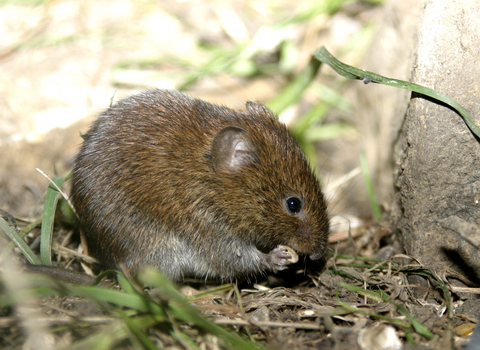
Bank vole ©Wildstock
Bank vole
Scientific name
Myodes glareolusWhen to see
January to DecemberSpecies information
Category
Statistics
Length: 8-12cmTail: 4-6cm
Weight: 15-40g
Average lifespan: 0.5-1.5 years
About
The bank vole lives in woodland, hedgerows, parks and gardens. It eats fruit, nuts and small insects, but is particularly keen on hazelnuts and blackberries. Bank voles are very active and agile animals, and are frequently seen - they even visit bird tables. They live in shallow burrows, but may make grassy, round nests above ground if the soil is unsuitable for digging. They have three or four litters a year, each with three to five young. Bank voles do not hibernate.How to identify
The bank vole is rich, chestnut-brown above, and white below. It is richer in colour than the similar field vole and has a proportionally longer tail. Voles have blunter, rounder faces, smaller ears and eyes, and shorter tails than mice.Distribution
Widespread, absent from most of the Channel Islands, the Isles of Scilly, most Scottish islands, Northern Ireland and the Isle of Man.In our area
Bank voles live around woodlands and hedgerows all over Shropshire. Like field voles, they are an important food source for owls and other birds of prey, so when vole numbers are low, it has an impact on local aerial predators too. Harsh winters can be bad for voles and other small rodents and in a very cold season, over 50% of the population could perish. Unlike hedgehogs and dormice, voles don't hibernate and they have to ensure that they pile up a large stock of food during the autumn to make sure that they have enough to keep then going until the spring. When natural food is in short supply, they will often venture into gardens to take advantage of fallen seeds dropped from bird feeders. To keep out of the worst conditions, they dig burrow systems through the roots of trees and shrubs deep underground, where the frosts don't reach. If it snows, they are also known to make tunnels underneath snow layers which they use as a way of moving around hidden from the view of predators such as foxes, owls and in many cases, domestic cats.
Did you know?
The bank voles that live on Skomer Island, Wales, have evolved into a unique subspecies known as the Skomer vole (Myodes glareolus skomerensis). They are larger and bolder than their mainland cousins.Bank voles live around woodlands and hedgerows all over Shropshire. Like field voles, they are an important food source for owls and other birds of prey, so when vole numbers are low, it has an impact on local aerial predators too. Harsh winters can be bad for voles and other small rodents and in a very cold season, over 50% of the population could perish. Unlike hedgehogs and dormice, voles don't hibernate and they have to ensure that they pile up a large stock of food during the autumn to make sure that they have enough to keep then going until the spring. When natural food is in short supply, they will often venture into gardens to take advantage of fallen seeds dropped from bird feeders. To keep out of the worst conditions, they dig burrow systems through the roots of trees and shrubs deep underground, where the frosts don't reach. If it snows, they are also known to make tunnels underneath snow layers which they use as a way of moving around hidden from the view of predators such as foxes, owls and in many cases, domestic cats.
